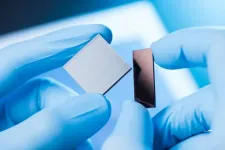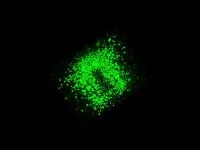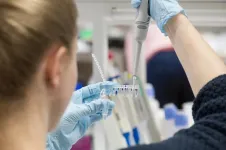Scientists take a bite out of solar efficiency challenge with sandwich model
The design of next-generation solar panels can now be improved thanks to a greater fundamental understanding of the structure within a key component
2021-05-19
(Press-News.org) In a world hungry for cheaper, more efficient renewable energy, Australian researchers have served up a treat.
Work led by the ARC Centre of Excellence in Exciton Science has shown that the two-dimensional (2D) thin films used in some perovskite solar cells closely resemble a sandwich. Perovskite is an exciting material at the forefront of solar energy research and design.
Previously, scientists thought these 2D perovskite films had a 'gradient' structure, in which certain components were found deep in the material, with other complementary elements only located nearer to the surface, like topping on a cracker.
However, in a paper published in Journal of Materials Chemistry C, members of Exciton Science based at the University of Melbourne, together with collaborators at Australia's national science agency CSIRO and Shandong University, have provided evidence for a sandwich-like structure, in which two layers of the same type (the bread) surround one central, contrasting layer (the filling).
This layout encourages excitons - quasiparticles important for converting sunlight to electricity - to move from the central layer to both surfaces of the film, while free carriers transport charge for collection by electrodes, helping to result in more efficient solar energy generation when incorporated into devices.
"A real problem has been understanding what the structure of these 2D perovskite solar cells really is," corresponding author Professor Ken Ghiggino said.
"There's been quite a lot of controversy in the literature. The advance that we've achieved is to find out what the real structure of these films is and how they work in a solar cell."
2D perovskite devices are of particular interest due to their superior stability and durability relative to '3D' perovskite cells. Prototype 2D devices, developed by the researchers using infrastructure and expertise at CSIRO, have demonstrated 13% efficiency.
With greater fundamental understanding of the structure, the researchers will now attempt to increase device efficiency by changing the thickness of the layers within the perovskite 'sandwich'.
In addition to solar cells, improved 2D perovskite films have important applications in light-emitting diodes (LEDs) and photodetectors, such as video imaging, optical communications, biomedical imaging, security, night-vision, gas sensing, and motion detection.
Lead author Dr Fei Zheng said: "This is the first time a sandwich structure has been proposed versus the conventional gradient distribution model. We think this discovery will help design and device optimisation for higher performance of the 2D cells and LEDs."
INFORMATION:
[Attachments] See images for this press release:

ELSE PRESS RELEASES FROM THIS DATE:
2021-05-19
Nearly a quarter of pregnant women say they've been around secondhand smoke - in their homes, at work, around a friend or relative - which, according to new research, is linked to epigenetic changes - meaning changes to how genes are regulated rather than changes to the genetic code itself - in babies that could raise the risk of developmental disorders and cancer.
The study, published today in Environmental Health Perspectives by researchers at Virginia Commonwealth University Massey Cancer Center, is the first to connect secondhand smoke during pregnancy with epigenetic modifications to disease-related genes, measured at birth, which supports the idea that many adult ...
2021-05-19
While a pint-sized snorer may seem adorable tucked up in bed, studies shows that children with sleep disordered breathing are likely to show aggressive and hyperactive behaviours during the day.
The recommended treatment is an adenotonsillectomy - the removal of adenoid and tonsils - not only to fix the snore, but also the behaviour.
Yet according to new research from the University of South Australia, while the surgery can cure a child's snoring it doesn't change their behaviour, despite common misconceptions by parents and doctors alike.
Conducted in partnership with the University ...
2021-05-19
The nerve cells, also called neurons, in our brain control all the basic processes of our body. For this reason, there are different types of neurons distributed over specific regions of the brain. Researchers at the Max Planck Institute for Metabolic Research and the CECAD Cluster of Excellence in Aging Research of the University of Cologne have developed an approach that allows them to show that neurons that are supposedly the same are actually very different: they not only sense different hormones for the body's energy state, but also have a different influence on food intake. This can have a direct effect on our metabolism, for example by differentially restraining our appetite.
The brain processes our sensory perceptions, controls our behaviour and stores ...
2021-05-19
Traditionally, an infection is thought to happen when microbes - bacteria, fungi, or viruses - enter and multiply in the body, and its severity is associated with how prevalent the microbes are in the body.
Now, an international research team led by Nanyang Technological University, Singapore (NTU Singapore) has proposed a new way of understanding infections. Their study of close to 400 respiratory samples from patients with bronchiectasis, a chronic lung condition, has shown that microbes in the body exist as a network, and that an infection's severity could be a result of interactions between these microbes.
Through statistical modelling ...
2021-05-19
Among the large cast of microbiome players, bacteria have long been hogging the spotlight. But the single-celled organisms known as protists are finally getting the starring role they deserve.
A group of scientists who study the interactions between plants and microbes have released a new study detailing the dynamic relationships between soil-dwelling protists and developing plants, demonstrating that soil protists respond to plant signals much like bacteria do.
An enormous variety and diversity of microbes live in soil, and studying how these organisms interact with each ...
2021-05-19
For young plants, timing is just about everything. Now, scientists have found that herbivores, animals that consume plants, have a lot to say about evolution at this vulnerable life stage.
Once a plant seedling breaches the soil surface and begins to grow, a broad range of factors will determine whether it thrives or perishes.
Scientists have long perceived that natural selection favors early rising seeds. Seedlings that emerge early in the growing season should have a competitive advantage in monopolizing precious soil resources. Early growth also should mean more access to light, since early growers can block sunlight for seedlings that emerge later in the season.
Despite plenty of proof that germinating early is highly advantageous, many plants germinate ...
2021-05-19
LA JOLLA, CALIF. - May 19, 2021 - A study led by scientists at Sanford Burnham Prebys Medical Discovery Institute has identified a tumor marker that may be used to predict which breast cancer patients will experience resistance to endocrine therapy. The research offers a new approach to selecting patients for therapy that targets HER2, a protein that promotes the growth of cancer cells, to help avoid disease relapse or progression of endocrine-sensitive disease.
The study was published in the journal Nature Communications.
Nearly 80% of breast tumors are estrogen receptor (ER)-positive. For decades, ...
2021-05-19
Turns out the old adage, "monkey see, monkey do," does ring true -- even when it comes to cannabis use. However, when cannabis use involves youth it's see, think, then do, says a team of UBC Okanagan researchers.
The team found that kids who grow up in homes where parents consume cannabis will more than likely use it themselves. Parental influence on the use of cannabis is important to study as it can help with the development of effective prevention programs, explains Maya Pilin, a doctoral psychology student in the Irving K. Barber Faculty of Arts and Social Sciences.
"Adolescence is a critical period in which drug and alcohol experimentation takes place and when cannabis use is often initiated," says Pilin. "Parents are perhaps the most influential socializing agent for ...
2021-05-19
People with bipolar disorder may not take their medication because of side effects, fear of addiction and a preference for alternative treatment - according to research from Norfolk and Suffolk NHS Foundation Trust (NSFT) and the University of East Anglia (UEA).
Nearly half of people with bipolar disorder do not take their medication as prescribed leading to relapse, hospitalisation, and increased risk of suicide.
A new study, published today, reveals six key factors that stop people taking their medication as prescribed.
These include whether they are experiencing side effects, difficulties in remembering to take medication and a lack of support from family, friends and healthcare ...
2021-05-19
Researchers at the University of Eastern Finland have found a potential neuroprotective effect of a protein modification that could be a therapeutic target in early Alzheimer's disease. The new study investigated the role of MECP2, a regulator of gene expression, in Alzheimer's disease related processes in brain cells. The study found that phosphorylation of MECP2 protein at a specific amino acid decreases in the brain as Alzheimer's disease is progressing. Abolishing this phosphorylation of MECP2 in cultured mouse neurons upon inflammatory stimulation enhanced their viability and ...
LAST 30 PRESS RELEASES:
[Press-News.org] Scientists take a bite out of solar efficiency challenge with sandwich model
The design of next-generation solar panels can now be improved thanks to a greater fundamental understanding of the structure within a key component







